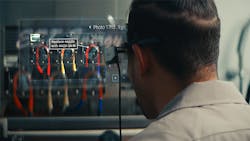Real-time collaboration between remote experts and on-site field personnel has become an ideal use case for the technology available today through smart glasses. Less experienced technicians can more easily and quickly get help with service tasks, making fewer mistakes and improving productivity. Many smart glass systems go beyond this scenario to provide mixed-reality capabilities with higher hardware and software costs, but Epson saw a need to make it simpler for companies to get started with their first steps into remote support.
Building on its Moverio smart glass platform, Epson has announced Moverio Assist—a see-what-I-see remote assistance and inspection application. Aimed at any organization with a field service team, Moverio Assist makes it easier for technicians to complete difficult repairs or work tasks in the field.
“It was so fundamental as a use case, we decided we needed to provide our own turnkey solution,” says Leon Laroue, technical product manager for augmented reality at Epson America. “It’s a much simpler, more basic solution that’s missing from the landscape.”
To use the Moverio Assist app, a field technician wears the Moverio BT-300 or BT-350 ANSI smart glasses with built-in camera, powers it on to connect to the Internet using Wi-Fi or a mobile hotspot, and then launches the app to initiate the call to experts logged into MoverioAssist.com.
The BT-300 and BT-350 glasses are standalone models that are wired to a controller that provides the power and means of interaction for the glasses. The BT-350 model includes an ANSI Z87.1 safety shield. Keeping the glasses wired to the control device was a design decision to make the glasses light, according to Laroue who says the Moverio smart glasses, at 68 g, are the lightest on the market.
“Also, by offboarding the battery and processor, it doesn’t get hot,” he adds, noting that a lot of headsets heat up around the temples and at the front of the glasses. “If you’re going to use them for hours at a time, you want them to be as lightweight and wearable as possible.”
Epson initially got into the smart glasses market about eight years ago because of its expertise in the projector business. Unlike many glass makers, Laroue says, Epson manufactures its own display panels. Moverio smart glasses use OLED panels with a proprietary waveguide that bounces light through a polycarbonate material and into a prism. “Our thing is really the quality of the display and the fact that it’s binocular,” he says, explaining that the binocular HD display puts information in front of the technician rather than in their periphery.
The smart glasses allow field technicians to view instructions, photos, PDFs, and videos in high quality, while also giving them a wearable display that minimizes visual obstruction and can be virtually transparent when necessary.
The focus with the Moverio Assist app is on see-what-I-see remote assistance and inspection use cases, providing video streaming, two-way audio, and file sharing to give field technicians a way to get expert help while performing difficult tasks.
There are similar systems that are phone- and tablet-based, but they are not hands-free and so do not facilitate work in the field, Laroue says. Meanwhile, augmented reality (AR) wearables such as Microsoft’s HoloLens emphasize a mixed-reality experience that is much more than many companies need. “We see remote assistance as being much more simple than that,” he says. “These are kind of overkill.”
As an example, HoloLens can lock content onto the real world, something that Laroue says is not needed in the field on a daily basis. And the increased capabilities require greater need for content creation and programming for the various machines. “The more you reach for these advanced features, the less turnkey it becomes,” he says.
Moverio Assist, as a software-as-a-service (SaaS) system, provides an easier on-ramp for companies that don’t want to do a custom build. “A lot of companies are interested in exploring these capabilities, but the on-ramp is missing,” Laroue says. “If people want to use remote assistance, this is their on-ramp; this is their simple solution.”
Epson has found that companies with field service teams typically want the video streaming and two-way audio, and almost never access other features. The turnkey system makes it easy to do just that. Showing other capabilities, Laroue describes a scenario in which the remote expert can snap a picture of what the field technician is looking at; he can then annotate the picture and send it back to the tech’s glasses, helping him to understand where he should be looking on the equipment.
Previously relying on partner software to pair with its smart glasses, Epson has created the Moverio Assist app in-house to make it simple for its customers to get started straight out of the box. It requires no calls to Epson and no pre-boarding process, Laroue says. “It’s all about reducing friction, reducing the barriers.”
Epson does provide support for scaling up as needed, making it easy to add as many users as wanted, with the ability to define the roles for each of those users. “It’s meant to be very simple, but it’s also supported at an enterprise SaaS level,” Laroue says, emphasizing that it’s enterprise-grade but still accessible to small and medium-sized businesses. “It’s really about making sure it’s robust, available, well-supported, and scalable.”
Available on a per-glasses, monthly subscription basis, Moverio Assist will have plans starting at $29.99 per month, with call plans much the same way cellphone plans work.
The service is live already but only available to a handful of users at this point. The offering will be publicly available in September. Some examples of companies already using the system in industry, Laroue says, include a manufacturer and service provider for conveyor belts in the food and beverage industry, as well as a provider of water treatment systems.
About the Author
Aaron Hand
Editor-in-Chief, ProFood World

Leaders relevant to this article:
